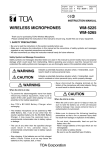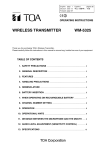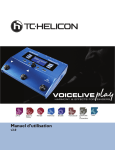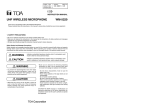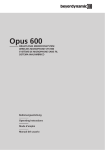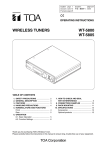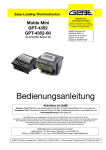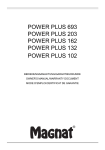Download WM-4210 WM-4220 UHF WIRELESS MICROPHONE
Transcript
English: page 1 Deutsch: seite 5 Français: page 9 OPERATING INSTRUCTIONS UHF WIRELESS MICROPHONE WM-4210 WM-4220 Please follow the instructions in this manual to obtain the optimum results from this unit. We also recommend that you keep this manual handy for future reference. 1. SAFETY PRECAUTIONS • Be sure to read the instructions in this section carefully before use. • Make sure to observe the instructions in this manual as the conventions of safety symbols and messages regarded as very important precautions are included. • We also recommend you keep this instruction manual handy for future reference. Safety Symbol and Message Conventions Safety symbols and messages described below are used in this manual to prevent bodily injury and property damage which could result from mishandling. Before operating your product, read this manual first and understand the safety symbols and messages so you are thoroughly aware of the potential safety hazards. WARNING Indicates a potentially hazardous situation which, if mishandled, could result in death or serious personal injury. CAUTION Indicates a potentially hazardous situation which, if mishandled, could result in moderate or minor personal injury, and/or property damage. WARNING • To prevent the electromagnetic wave from badly influencing medical equipment, make sure to switch off the unit's power when placing it in close proximity to the medical equipment. CAUTION • When the unit is not in use for 10 days or more, be sure to take the battery out of the unit because battery leakage may cause personal injury or contamination of environment. • Make sure to observe the following handling precautions so that a fire or personal injury does not result from leakage or explosion of the battery. · Do not short, disassemble, heat nor put the battery into a fire. · Never charge batteries of the type which are not rechargeable. · Do not solder a battery directly. · Be sure to use the specified type of battery. · Note correct polarity (positive and negative orientation) when inserting a battery in the unit. · Avoid locations exposed to the direct sunlight, high temperature and high humidity when storing batteries. 2. GENERAL DESCRIPTION The WM-4210 Wireless Microphone employs a dynamic microphone element and is suitable for vocal applications. The WM-4220 Wireless Microphone employs an electret condenser microphone element and is suitable for speech applications. 3. FEATURES • One frequency can be selected from 16 operating frequencies of 690 – 865 MHz. • An optimized PLL-synthesizer minimizes the oscillation frequency drift resulting from the ambient temperature or voltage fluctuation. • Battery lamp indicates battery consumption to prevent the unit from malfunctioning when the battery level remarkably decreases. 4. HANDLING PRECAUTIONS • Do not expose the unit to rain or an environment where it may be splashed by water or other liquids, as doing so may result in unit failure. • Never open nor remove the unit case to modify the unit. Refer all servicing to your nearest TOA dealer. • Take care not to drop the unit onto the floor nor bump it against a hard object as the unit could fail. • Do not place the unit in locations of high temperature (ex. in a car parked in summer) or high humidity as the unit could fail. • Do not use the unit in locations where it is exposed to seawater. • To clean, use a dry cloth. When the unit gets very dirty, wipe lightly with a cloth damped in a dilute neutral cleanser, then wipe with a dry cloth. Never use benzine, thinner, or chemically-treated cleaning towel. • Avoid using a mobile telephone near the wireless microphone in use. Noise could be picked up. 5. NOMENCLATURE [WM-4210] [WM-4220] Power/Battery lamp (Orange LED) Power ON/OFF switch Channel select switch Battery clip 2 6. BATTERY INSERTION Step 1. Hold the microphone body and rotate the microphone grip counterclockwise to remove it. Step 2. Insert the battery 6LR61 (Alkaline 9 V) according to the instructions attached to the inside of the battery compartment. Pay attention to the correct polarity when inserting the battery. Step 3. Replace the microphone grip by sliding and rotating it clockwise. 2 1 Battery replacement • A brand-new battery will provide the power enough to operate the unit continuously for 10 hours. • As long as the battery has sufficient power for the microphone to function properly, the orange LED will light. When the orange LED starts to fade and then flash, replace it with a new one. Orange LED Indicates the battery level by lighting or flashing. 7. OPERATION Step 1. Make sure that the receiver and the wireless microphone are of the same channel (frequency). Step 2. If they are not identical in channel, you have to adjust the channel switch. Step 3. Place the microphone ON/OFF switch in the ON position. The orange LED indicates the circuit is active. Step 4. Make sure to shift the ON/OFF switch back to the OFF position after using the wireless microphone. 8. OPERATIONAL HINTS • The microphone's service distance is 3 – 120 m. When the microphone user moves in a facility, signal dropouts (momentary losses of signal reception) may be encountered. These dropouts are caused by the building's architectural designs or materials which block the travel of or reflect the radio signal. If this occurs, the user needs to change locations for better signal reception. • The proper operation of your wireless system may be interfered with by other system operating on the same frequency. In such cases, change the operating frequency of your system. (As to dealing with the interference, refer to the operating instructions of the wireless tuner.) • Should you have any questions regarding the use or availability of TOA wireless products, please contact your local TOA dealer. 9. CHANNEL NUMBER SETTING Step 1. Switch off the power. Rotate the microphone grip counterclockwise to remove it. Step 2. Using the supplied screwdriver, set the Channel setting switch pointer to the desired channel number. Step 3. Replace the microphone grip. Note: Make sure that the wireless microphone is identical to the wireless tuner in the channel number. Should the microphone's setting differ from that of the tuner, the tuner does not receive the microphone signal. 3 10. SPECIFICATIONS Model No. Microphone Element Emission Frequency Range Selectable Channel RF Carrier Power Tone Frequency Maximum Input Level Maximum Deviation Audio Frequency Response Dynamic Range (AF Circuit) Battery Battery Life Indicator Antenna Operating Temperature Finish Dimensions Weight WM-4210 Dynamic type Cardioid pattern WM-4220 Electret condenser type Cardioid pattern F3E 690 – 865 MHz, UHF 16 channels Less than 50 mW 32.768 kHz 130 dB SPL 125 dB SPL ±40 kHz 100 – 12,000 Hz 200 – 12,000 Hz More than 100 dB (with WT-4810) 6LR61 (9 V x 1) More than 10 hours (alkaline) Power/Battery lamp (orange LED) Built-in type –10 to +50°C Resin, coating, dark gray ø50 x 235.2 mm ø45 x 235.2 mm 270 g (with battery) 250 g (with battery) Note: The design and specifications are subject to change without notice for improvement. • Accessories Microphone holder (with stand adapter) ............... 1 Screwdriver (for setting) ....................................... 1 Storage case ........................................................ 1 4 Bedienungsanleitung UHF Drahtlos-Mikrofon WM-4210 WM-4220 Bitte folgen Sie den Hinweisen in dieser Bedienungsanleitung, um optimale Ergebnisse zu erzielen. Bewahren Sie die Bedienungsanleitung sorgfältig und zugänglich auf. Bitte entnehmen Sie aus der beiliegenden Tabelle die Frequenzen, die im jeweiligen Staat genutzt werden können. Beachten Sie unbedingt auch den folgenden Hinweis! WICHTIGER HINWEIS! Melden Sie Ihr Drahtlossystem vor dem ersten Einschalten bei der zuständigen Behörde an. Erläuterung für Deutschland: Das Drahtlosmikrofon darf erst nach Zuteilung von Frequenzen zur Nutzung für den Betrieb bei der zuständigen Außenstelle der Regulierungsbehörde für Telekommunikation und Post (RegTP) und auch nur auf den zugeteilten Frequenzen betrieben werden! Bei Zuwiderhandlungen kann die Behörde Strafmaßnahmen gegen Sie erwirken. Antragsformulare erhalten Sie bei der Regulierungsbehörde für Telekommunikation und Post (RegTP) oder über das Internet unter "www.regtp.de". Von der Homepage der RegTP navigieren Sie wie folgt: • (linke Spalte) Regulierung Telekommunikation... • (rechte Spalte) Frequenzverwaltung • (rechte Spalte) Funkdienste-spezifische Angelegenheiten • (rechte Spalte) Nichtöffentlicher Mobilfunk, Satellitenfunk • (rechte Spalte) Anträge und Ausfüllhinweise • (mittlere Spalte): laden Sie die Formulare unter der Überschrift "Durchsage-Funk". DER BETRIEB IM FREQUENZBEREICH VON 863,1 MHZ BIS 864,9 MHZ IST NICHT ANMELDEPFLICHTIG. 1. SICHERHEITSHINWEISE Die folgenden Sicherheits- und Warnhinweise sind zu Ihrem Schutz aufgeführt. Bitte lesen Sie diese sorgfältig durch. WARNUNG Zeigt eine potenziell gefährliche Situation auf. Die Nichtbeachtung der Warnhinweise kann zu Verletzungen, möglicherweise auch mit tödlichem Ausgang, führen. • Das Mikrofon bitte nach Gebrauch immer ausschalten. Insbesondere ist darauf zu achten, dass es zu keiner gegenseitigen Beeinflussung mit Medizintechnischen Geräten kommt. ACHTUNG Zeigt eine potenziell gefährliche Situation auf. Die Nichtbeachtung dieser Hinweise kann zu Verletzungen oder Sachschäden führen. Das Funkmikrofon wird mit Batterien betrieben. • Verwenden Sie nur die angebenen Batterietypen und achten Sie beim Einsetzen auf die korrekte Polung. • Nehmen Sie die Batterien aus dem Mikrofon, wenn dieses länger als 10 Tage ausser Betrieb genommen wird. Auslaufende Batterien können zu Schäden am Mikrofon führen. • Werfen Sie verbrauchte Batterien nicht in den Müll oder ins offene Feuer. Schließen Sie keine Batterien kurz und öffnen Sie diese niemals. • Setzen Sie Batterien auch nicht starkem Sonnenlicht, Hitze oder Regen aus. Laden Sie niemals Batterien auf. 5 2. ALLGEMEINE BESCHREIBUNG Das WM-4210 Drahtlos-Mikrofon verwendet eine dynamische Mikrofonkapsel mit großen Dynamikreserven. Es ist besonders geeignet für Gesang. Das WM-4220 Drahtlos-Mikrofon verwendet eine Elektret – Kondensatormikrofonkapsel und ist besonders für Sprachübertragungen geeignet. 3. LEISTUNGSMERKMALE • Eine von 16 Sendefrequenzen kann wahlfrei eingestellt werden. Die Sendefrequenzen liegen im Bereich von 690 – 865 MHz. • Ein optimierter PLL-Synthesizer sorgt für stabile Sendefrequenzen auch bei wechselnden Umgebungsbedingungen. • Die Batterieanzeige signalisiert den nötigen Batteriewechsel bei deutlichem Spannungsabfall, bevor die niedrige Spannung zu Fehlfunktionen führen kann. 4. VORSICHTSMAßNAHMEN BEI DER HANDHABUNG • Verhindern Sie das Eindringen von Feuchtigkeit in das Mikrofon um Fehlfunktionen oder Schäden zu vermeiden. • Überlassen Sie Eingriffe in das Gerät ausschließlich autorisierten Fachleuten. • Vermeiden Sie starke Stöße, die das Mikrofon beschädigen könnten. • Setzen Sie das Mikrofon nicht hohen Temperaturen oder sehr hoher Luftfeuchtigkeit aus. Beides kann zu Funktionsstörungen führen. • Betreiben Sie das Mikrofon nicht in Umgebungen, in denen es mit Seewasser in Berührung kommen kann. • Reinigen Sie das Mikrofon mit einem trockenen oder leicht angefeuchtetem Tuch. Wischen Sie das Mikrofon nach der Reinigung wieder trocken. Verwenden Sie auf keinen Fall Lösungsmittel, Reinigungsbenzin oder sonstige chemische Reinigungsstoffe. • Schalten Sie das Mikrofon aus, solange Sie oder eine Person in Ihrer unmittelbaren Umgebung ein Handy benutzen. 5. BEDIENELEMENTE [WM-4210] [WM-4220] Betriebs- / Batterieanzeige (Orange LED) Ein / Ausschalter Wahlschalter für den Frequenzkanal (16 Positionen) Batteriehalter 6 6. EINSETZEN DER BATTERIE Schritt 1. Drehen Sie das Gehäuseunterteil gegen den Uhrzeigersinn, bis Sie es abnehmen können. Schritt 2. Setzen Sie eine 9V Blockbatterie ein. (Typ 6LR61 oder äquivalent.) Folgen Sie der im Batteriefach angebrachten Anleitung. Achten Sie dabei besonders auf die richtige Polarität. Schritt 3. Setzen Sie das Gehäuseunterteil wieder auf und drehen Sie es im Uhrzeigersinn wieder fest. 2 1 Batteriewechsel • Eine neue Batterie reicht für ca. 10 Sunden Dauerbetrieb. • Solange die Batterie genug Strom liefert, leuchtet die Betriebsanzeige konstant. Wenn die Helligkeit der Anzeige [Orange LED] abnimmt oder sie sogar blinkt, muß die Batterie ersetzt werden. Orange LED Betriebsanzeige 7. BEDIENUNG Schritt 1. Stellen Sie sicher, dass Mikrofon und Empfänger auf den gleichen Frequenzkanal eingestellt sind. Schritt 2. Schalten Sie das Mikrofon ein; die Betriebsanzeige leuchtet. Schritt 3. Schalten Sie das Mikrofon nach Gebrauch wieder ab. 8. HINWEISE ZUM BETRIEB • Die Reichweite Ihres Mikrofons ist – abhängig von den Umgebungsbedingungen – maximal 120m. Innerhalb von Gebäuden kann es stellenweise zu kurzen Aussetzern in der Übertragung kommen. Diese Aussetzer werden durch die baulichen Gegebenheiten verursacht. Wählen Sie dann einen anderen Standort. • Andere elektronische Geräte, die im gleichen Frequenzbereich wie Ihr TOA – Drahtlosmikrofon arbeiten, können die Übertragung beeinträchtigen. Stellen Sie dann Ihr TOA – Drahtlosmikrofon auf eine freie, ungestörte Frequenz ein. • Falls Sie weitergehende Fragen zu TOA – Drahtlosprodukten haben, wenden Sie sich an Ihren TOA – Händler. 9. KANALWAHL (CHANNEL) Schritt 1. Schalten Sie das Mikrofon aus. Drehen Sie das Gehäuseunterteil gegen den Uhrzeigersinn, bis Sie es abnehmen können. Schritt 2. Verwenden Sie den mitgelieferten Schraubendreher, um den gewünschten Frequenzkanal einzustellen. Schritt 3. Setzen Sie das Gehäuseunterteil wieder auf und drehen Sie es im Uhrzeigersinn wieder fest. Achtung! Stellen Sie sicher, dass Mikrofon und Empfänger auf den gleichen Frequenzkanal eingestellt sind. Nur dann kann Ihr TOA - Drahtlossystem ordnungsgemäß funktionieren. 7 10. TECHNISCHE DATEN Mikrofon Element Modulation Sendefrequenzband Verfügbare Kanäle HF Abstrahlung Kenntonfrequenz Max. Eingangspegel Frequenzhub Übertragungsbereich Dynamikumfang Batterietyp Batterielebensdauer Anzeigen Antenne Umgebungstemperatur Ausführung Abmessungen Gewicht WM-4210 Dynamisch, Richtcharakteristik Niere WM-4220 Elektret-Kondensator, Richtcharakteristik Niere FM-Modulation 690 – 865 MHz, UHF 16 (national verschieden) Weniger als 50 mW 32,768 kHz 130 dB SPL 125 dB SPL max. +/– 40 kHz 100 – 12.000 Hz 200 – 12.000 Hz größer 100 dB (in Verbindung mit WT-4810) 6LR61 (9 V x 1) 10 Stunden (Alkali Mangan) 1 für Ein/Aus/Batteriestatus Ins Mikrofon integiert –10 to +50°C dunkelgrau beschichteter Kunstharz Durchmesser 50 mm; Durchmesser 45 mm; Länge 235,2 mm Länge 235,2 mm 270 g (mit Batterie) 250 g (mit Batterie) Anmerkung: Änderung der technischen Daten ohne Vorankündigung vorbehalten • Zubehör Mikrofonhalter (mit Stativadapter) ........................ 1 Schraubendreher (für Einstellungen) ................... 1 Aufbewahrungsbox .............................................. 1 8 NOTICE D'UTILISATION MICROPHONE SANS FIL UHF WM-4210 WM-4220 Merci de suivre les instructions de cette notice afin d'obtenir les meilleurs résultats de votre appareil. Nous vous recommandons aussi de la conserver toujours en tant que notice de référence. 1. CONSEILS DE SECURITE • Lisez attentivement les instructions ci-dessous avant toute utilisation. • Suivez les recommandations signalées par les symboles de sécurité. elles contiennent des informations très importantes. • Nous vous recommandons aussi de la conserver toujours en tant que notice de référence. Symboles de sécurité et conventions Les symboles et messages de sécurité décrits ci-dessous sont utilisés dans cette notice pour prévenir tout dommage corporel ou matériel pouvant résulter d'une mauvaise utilisation. Lisez attentivement cette notice pour comprendre parfaitement les symboles et messages de sécurité pour prévenir tout risque éventuel. AVERTISSEMENT Indique une situation risquant d'entraîner des blessures sérieuses, voire la mort. ATTENTION Indique une situation risquant d'entraîner des blessures moyennement graves ou mineures, et/ou des dommages matériels. AVERTISSEMENT • Pour prévenir toute inflence néface des ondes électromagnétiques sur le matériel médical, veillez à mettre l'appareil hors tension lorsqu'il est placé à proximité de ce type de matériel. ATTENTION • Lorsque vous n'utilisez pas l'appareil pendant 10 ou plus, retirez la batterie de l'appareil afin d'éviter tout coulage pouvant entraîner des blessures ou la contamination de l'environnement. • Respectez les précautions de manipulation suivantes pour éviter tout risque de blessure ou d'incendie dû à une fuite ou explosion de la batterie. · Ne pas endommager, démonter, chauffer ou mettre la batterie au feu. · Ne jamais recharger des batteries qui ne sont pas prévues à cet effet. · Ne pas souder une batterie directement. · Veiller à utiliser le type de batterie spécifié. · Respecter la polarité (orientation positive et négative) lorsque vous insérez une batterie. · Stocker les batteries à l'abri du soleil, de la chaleur et de l'humidité. 9 2. DESCRIPTION GENERALE Le microphone sans fil WM-4210 utilise un microphone dynamique à grande capacité d'entrées. Il est prévu pour les applications vocales. Le microphone sans fil WM-4220 utilise un microphone electret condensateur. Il est prévu pour les applications de la parole. 3. CARACTERISTIQUES • On peut sélectionner une fréquence parmi les 16 fréquences de 690 à 865 MHz. • Un synthétiseur PLL optimisé permet de minimiser la dérive de la fréquence des oscillations due aux fluctuations de la température ambiante ou de la tension • Un témoin de batterie indique le niveau de consommation de la batterie pour prévenir tout dysfonctionnement losque le niveau de charge de la batterie diminue sérieusement. 4. PRECAUTIONS D'USAGE • Ne pas exposer l'appareil à la pluie et le protéger de tout contact avec des liquides afin d'éviter tout risque de panne. • Ne jamais ouvrir ou retirer le boîtier de l'appareil pour le modifier. Contactez votre représentant TOA le plus proche. • Veiller à ne pas faire tomber l'appareil ou le cogner contre un objet dur pour éviter un risque de panne. • Ne pas exposer l'appareil à des températures élevées (ex. dans une voiture en été) ou à une forte humidité qui pourraient endommager l'appareil. • Ne pas utiliser l'appareil dans des endroits exposés à l'eau de mer. • Utiliser un chiffon sec pour le nettoyage. Si l'appareil est très sale, nettoyer avec un chiffon humecté de nettoyant neutre, puis un chiffon sec. Ne jamais utiliser de l'essence, un solvant ou une lingette chimique. • Eviter d'utiliser un téléphone mobile à proximité du microphone sans fil utilisé pour éviter toute interférence. 5. NOMENCLATURE [WM-4210] [WM-4220] Témoin alim./batterie (LED orange) Bouton ON/OFF Sélecteur de canal Clip batterie 10 6. INSERTION DE LA BATTERIE Etape 1. Tenir le microphone et faire tourner le boîtier du microphone dans le sens anti-horaire. Etape 2. Insérer la batterie 6LR61 (Alcaline 9 V) selon les instructions figurant à l'intérieur du compartiment. Respecter la polarité lorsque vous insérez la batterie. Etape 3. Remettre le boîtier du microphone en le faisant tourner dans le sens des aiguilles d'une montre. 2 1 Remplacement de la batterie • Une batterie neuve permet d'assurer un fonctionnement du microphone durant 10 heures en utilisation continue. • Tant que la batterie est suffisamment chargée pour assurer le fonctionnement correct du microphone, la LED orange reste allumée. Ensuite, la LED faiblit, puis se met à clignoter. Remplacer alors la batterie. LED orange Indique le niveau de charge de la batterie (clignotant ou allumé) 7. FONCTIONNEMENT Etape 1. S'assurer que le récepteur et le microphone sans fil sont sur le même canal (fréquence). Etape 2. S'ils ne sont pas sur le même canal, procéder au réglage à l'aide du sélecteur de canal. Etape 3. Mettre le bouton ON/OFF du microphone sur la position ON. La LED orange indique que le circuit est actif. Etape 4. S'assurer que le bouton ON/OFF a bien été remis sur la position OFF après utilisation du microphone. 8. CONSEILS D'UTILISATION • La distance d'utilisation du microphone est comprise entre 3 et 120 m. Lorsque l'utilisateur se déplace, il peut y avoir des pertes de signal (pertes momentanées de la réception). Ces pertes peuvent provenir des conceptions architecturales des bâtiments ou des matériaux qui empêchent la transmission ou qui réfléchissent les signaux radio. Si tel est le cas, l'utilisateur doit rechercher en endroit plus favorable à la réception du signal. • Le fonctionnement de votre système sans fil peut subir les interférences d'un système utlisant la même fréquence. Dans ce cas, changer la fréquence utilisée par votre système. Pour ce qui est des interférences, reportez-vous aux instructions relatives au tuner sans fil. • Si vous avez des questions sur l'utilisation ou sur la disponibilité des produits sans fil TOA, n'hésitez pas à contacter votre représentant local TOA. 9. PARAMETRAGE DU CANAL Etape 1. Mettre hors tension. Faire tourner le boîtier du microphone dans le sens anti-horaire pour le retirer. Etape 2. A l'aide du tournevis fourni, amener le sélecteur de canal sur le numéro de canal désiré. Etape 3. Remettre le boîtier du microphone. Nota: Veiller à ce que le microphone et le tuner sans fil soient réglés sur le même numéro de canal. Dans le cas contraire, le tuner ne peut pas recevoir le signal du microphone. 11 10. SPECIFICATIONS Modèle Réf. Microphone Emission Gamme de fréquence Sélection de canal Puissance de sortie RF Fréquence de tonalté Niveau d'entrée maximum Déviation maximale Bande passante Gamme dynamique (AF Circuit) Batterie Durée batterie Indicateur Antenne Température (fonctionnement) Finition Dimensions Poids WM-4210 Dynamique modèle cardioïde WM-4220 Condensateur electret modèle cardioïde F3E 690 – 865 MHz, UHF 16 canaux < 50 mW 32,768 kHz 130 dB SPL 125 dB SPL ±40 kHz 100 – 12.000 Hz 200 – 12.000 Hz > 100 dB (avec WT-4810) 6LR61 (9 V x 1) > 10 heures (alcaline) témoin lumineux alim./batterie (LED orange) intégrée –10 à +50°C Résine, gris foncé ø50 x 235,2 mm ø45 x 235,2 mm 270 g (avec batterie) 250 g (avec batterie) Nota: La conception et les spécifications sont susceptibles de modifications sans préavis dans un souci d'amélioration. • Accessoires Support microphone (avec adaptateur pour pied) .......... 1 Tournevis (pour les réglages) ......................................... 1 Coffret de rangement ..................................................... 1 Printed in Taiwan 133-07-180-9A













